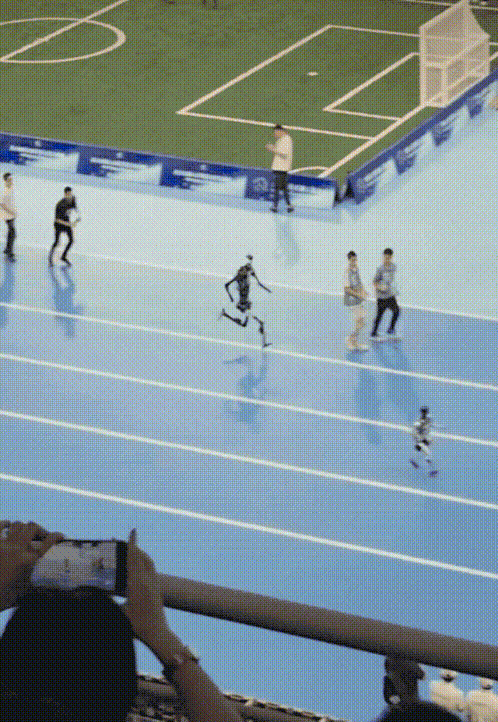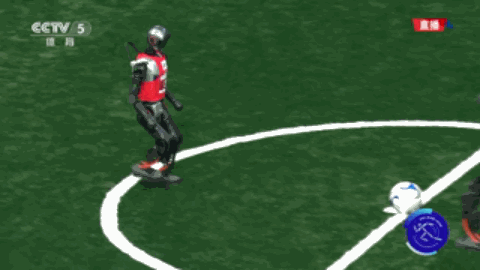The first "Olympics" for humanoid robots has arrived. The contestants made a complete fool of themselves. Does just making it to the arena mean winning?
By the halfway point of 2025, countless small and large robot competitions and exhibitions had been held.
Times have changed. Driven by the concept of embodied intelligence, robots now have the ability to think and serve actively and are on the verge of mass production and market launch. Various AI technology companies are quickly entering the arena, and even automakers are getting in on the action. In plain terms, robots can no longer just be used to show off technology. Instead of just providing science education in museums, they now need to be tested by the public and the market and put to practical use like "cyber workhorses."
But how can the market see the capabilities and technological achievements of robots, and which robots are more capable? The answer lies in sports games and various competitions.
On August 15th, after a grand opening ceremony, the 2025 World Humanoid Robot Games officially kicked off at the National Speed Skating Oval "Ice Ribbon" and the National Stadium "Bird's Nest" in Beijing. With participation from 16 countries including the United States, Germany, Japan, and Brazil, a total of 280 teams took part. Among them, there were 192 university teams and 88 enterprise teams. Over 500 robots from 127 brands participated in this sporting event, including those from Unitree, Digital Shanhai, Tianzhuo, etc.
(Photo from @Unitree Technology)
This year's Humanoid Robot Games featured 26 events and 487 matches, including track and field, football, basketball, dance, martial arts, table tennis, and other sports, as well as service - related competition items such as hotel scene cleaning services, industrial scene material handling, and pharmaceutical scene medicine unpacking and packaging. The games lasted until the afternoon of August 17th. We've watched many Olympic Games, but this "Olympics" for humanoid robots is truly novel.
From previous marathons, football, and boxing matches, we've seen the very "real" side of humanoid robots. Some robots had numerous glitches, adding a lot of entertainment to the competitions. We wonder if humanoid robots can still handle this seemingly grand and formal comprehensive world - class event with ease?
The games are like "playing house," and the entertainment factor still outweighs the event itself
First, why a "humanoid robot" games?
From the nature of the games, we can see that there are many types of events in a comprehensive competition. Earlier, Lei Technology also outlined the content of this year's games. From track and field to dance, from handling to packaging, only humanoid robots have the form to handle these scenarios. For example, a robot designed specifically for running may not be able to dance, and a robot designed for service may not be good at running. Form determines their versatility.
At the same time, the posture control algorithm, energy consumption (endurance), degrees of freedom, and weight of humanoid robots are the most difficult aspects to perfect.
In this year's games, Unitree brought two teams. One was led by Unitree Technology, and the other was led by Beijing Lingyi Technology, a subsidiary of Unitree Technology. In the first 1500 - meter race, Unitree Technology won the group first place with a time of 7 minutes, 10 seconds, and 28 milliseconds. Subsequently, the Unitree H1 led by Beijing Lingyi Technology won the 1500 - meter race championship with a time of 6 minutes, 34 seconds, and 40 milliseconds and received a 50,000 - yuan bonus.
(Photo from @Unitree Technology)
After the game, some spectators were curious why some robots on the field wore shoes while others didn't. Regarding this question, Wang Xingxing, the founder and CEO of Unitree Technology, said that Unitree's robot soles are relatively wear - resistant, so they basically don't need to wear shoes.
Unitree robots' running ability is not just for show. In an official long - distance running test on April 28th, to prove the running performance of its robots, the Unitree G1 completed 40 laps of long - distance running (13.2 kilometers) in 118 minutes, only changing the battery once during the process. The official website shows that the Unitree H1 can reach a moving speed of 3.3 m/s, with a potential sports performance of over 5 m/s. In other words, as long as the team optimizes well, the H1 has strong running ability.
Interestingly, from the live footage, it seems that Unitree robots are not interested in running. They often run onto the opponents' lanes or spin around on the track for no reason, making the whole audience burst into laughter. Some people even captured that a Unitree robot knocked down a real - life operator of a competitor during the race and then "escaped" as if nothing had happened.
(Photo from @Zhai Sheng)
Maybe knocking down the operator is also a tactic to defeat the opponent...
The 5 - on - 5 football game was also full of embarrassing moments. Humanoid robots rely on real - time calculations, which means there will be many unstable situations during the game. For example, the robots from both teams crowded together to fight for the ball, and there were even cases of robots on the same team competing with each other. The scene was very much like a "brawl." Some robots could stand up on their own after falling, while others fell again soon after standing up.
The good news is that the robots abide by the rules very well. For example, they will step back voluntarily when taking a throw - in.
The scene of the boxing match was similar to that of football and running. It can be said that there has not been much substantial improvement compared with previous single - event competitions. Robots still made mistakes as before. Only the dance performance showed some good coordination. In Lei Technology's view, with the current degrees of freedom and control algorithms of humanoid robots, it will obviously take more time to master such highly professional sports events and competitions. It's a pity that Musk's "Optimus" did not participate.
On the bright side, the Humanoid Robot Games brought some happy moments, and the entertainment factor was off the charts. Winning or losing didn't matter much.
The robots made a fool of themselves. Does just being on the field mean victory?
It has been some time since the previous marathons, football, and boxing matches. The performance of robots in the 2025 World Humanoid Robot Games should have been better. However, their embarrassing performance in such a formal international event is not the fault of the teams and robot companies for "slacking off." It's just that the general humanoid form is not easy to develop.
Different from real - life sports games, the "physical fitness" differences between robots are not as large as expected. Even more, one robot may participate in multiple events, while for humans, Liu Xiang is for the hurdles and Ma Long is for table tennis. One person for one event. A robot can be a "multi - functional warrior."
Take university teams as an example. The robot models are almost "uniform." For example, both the Beihang Zhiyuan Team and the BUPT/China University of Mining and Technology Dalian Team use the Unitree G1. On the Unitree official website, the G1 also has a special version called "Iron Fist King." The robots playing football also basically have the same model.
The hardware gap is almost zero. Why do some robots seem normal while others cause a lot of jokes? The key lies in the software algorithms, which are not easy to develop. Taking the Unitree G1 as an example, it has a maximum of 43 degrees of freedom in hardware and a maximum joint torque of 120 N·m. In software, it is equipped with the Unitree Robot Unified Large Model UnifoLM, which has stronger imitation and reinforcement learning capabilities. The "Iron Fist King" also introduced a motion - capture training program specifically for boxing. It has professional - level standard movements and supports somatosensory operation, joystick control, and voice control.
(Photo from CCTV5 live broadcast)
In essence, these are just the platform capabilities provided by robot manufacturers. It doesn't mean that the robots will be powerful right out of the box. It all depends on the algorithm optimization level of the team. The football game is a typical example. On the one hand, humanoid robots need algorithms and motors to maintain balance at all times. On the other hand, football - playing robots operate completely without human control, relying only on real - time calculations. How robots cooperate with each other, how to distinguish teammates and opponents, and how to kick the ball all rely on algorithms, which is the most difficult part of development.
Even for humans, it takes years to train a professional football player who can compete on the international stage. How much more difficult is it for robots, which are built with lines of code and a pile of sensing hardware and require good software - hardware cooperation? The World Humanoid Robot Games are a "public exam" for the level of general humanoid robots. On the one hand, it can more directly show the gap between Chinese and foreign algorithm teams. On the other hand, it can also let the public know the current general level of humanoid robots.
But this is just the first world - class comprehensive games for general humanoid robots. It's normal for them to make some blunders. On the bright side, it can add some fun.
In the long run, international competitions with a competitive nature can, to a certain extent, force the iteration of general humanoid robot algorithms and the progress of hardware technology. The competition events in the games can test the robots' "brains" and physical flexibility. Robots trained on the field will obviously have a positive impact on their future entry into various industries as "workhorses."
After all, in the automotive industry, most of the technologies used in civilian cars are developed by automakers through top - level international competitions.
By participating in world - class events, robots are trying to "step out of the PPT"
In Lei Technology's opinion, compared with the first robot marathon, at least in the first World Humanoid Robot Games, most robots successfully took their "first steps." However, there is still a lot of room for improvement in terms of endurance. In addition to the software algorithms mentioned earlier, the durability of robot parts and their ability to withstand high - intensity competitions determine the probability of them causing problems when they enter human society to serve in the future.
Even a "workhorse" that can't endure hardship won't be accepted by a factory, let alone a robot. So, letting robots participate in public competitions and make some blunders can help enterprises and R & D teams discover problems and accumulate competition experience, which can be improved and optimized later. Otherwise, robots can only exist in concepts or museums as "technological ornaments" that show off but are not very useful.
As the saying goes, you should look at a person with new eyes after three days' absence. Maybe in the next World Humanoid Robot Games, we'll see more formal competitions.



